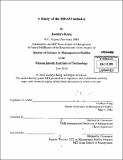A study of the DRAM industry
Author(s)
Kang, Joonkyu
DownloadFull printable version (3.493Mb)
Other Contributors
Sloan School of Management.
Advisor
Michael A. Cusumano.
Terms of use
Metadata
Show full item recordAbstract
Samsung Electronics as a DRAM provider has kept its leadership in the DRAM market with leading technology and production capacity since the 1990s even though there were unpredictable market fluctuations and dramatic changes in competition. Through the depressed market starting from 2006 to 2008, and the financial crisis, Samsung Electronics tightened its leading position in the DRAM market with changes in the dynamics of competition. But, from the industry wide view, the IT industry is getting complex since its system change from vertical integration to horizontal ecosystem. Also, the shrinkage of optical lithography, the main technical issue in semiconductor industry, is predicted to reach the uppermost limit. In this sense, Samsung Electronics as a DRAM provider should analyze and evaluate its current position in the DRAM market and the IT industry and needs to set a strategic goal and methods for sustaining its current position and also pursue more growth. I examine the current DRAM market dynamics, diagnose Samsung's current business status and strategy in the DRAM industry, and try to find a way to create value as a complementor in diverse IT industries. Furthermore, I will try to find opportunities where Samsung can sustainably capture value in the DRAM market. For this analysis, I use several frame works and concepts: Value creation and capture, Michael Porter's five forces analysis and Value Chain, Departure from a perfect competitive market, Ecosystem, and Complementor.
Description
Thesis (S.M.)--Massachusetts Institute of Technology, Sloan School of Management, 2010. Cataloged from PDF version of thesis. Includes bibliographical references (p. 64).
Date issued
2010Department
Sloan School of ManagementPublisher
Massachusetts Institute of Technology
Keywords
Sloan School of Management.